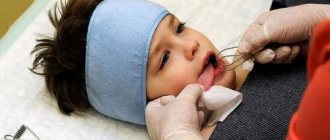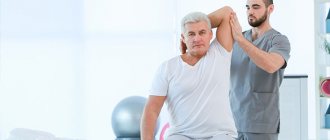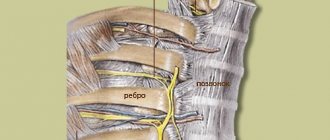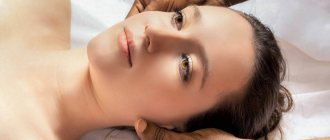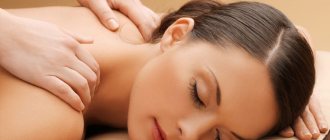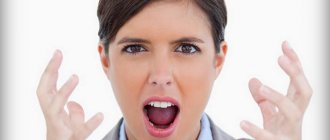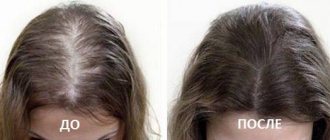Correction of dysarthria with massage in children
Speech therapy massage for various forms of dysarthria involves mechanical effects on various parts of the face and on the tongue. As a result, pathological symptoms in the peripheral part of the speech apparatus are eliminated, and muscle tone changes.
As a result, in the child, the strength of muscle spasms and their number decreases, and muscle tone normalizes with dysarthria (articulatory and facial muscles). The mobility of the speech organs is restored, blood flow in the soft tissues of the face and brain improves.
These factors help improve the quality of speech: it becomes smooth, expressive, and understandable to others. The baby begins to behave calmer and sleeps better.
Speech therapy massage is prescribed only by a speech therapist after a detailed examination. The specialist assesses the degree of the violation and, depending on this, selects an individual correction scheme.
Self-massage in the correction of erased dysarthria in preschool children
Bulanova E.N.
Self-massage in the correction of erased dysarthria in preschool children
Speech therapy massage is one of the methods of correctional and pedagogical intervention for severe speech disorders and has been used in practice for quite a long time. The theoretical prerequisite for the use of massage is the work of S.A. Bortfeld, O.V. Pravdina, K.A. Semenova, M.B. Eidinova and others. The most relevant use of speech therapy massage is for disorders such as dysarthria. Dysarthria is a violation of the sound-pronunciation and melodic-intonation aspects of speech, caused by insufficient innervation of the muscles of the speech apparatus.
In working to overcome dysarthria, self-massage is one of the effective methods of correctional and pedagogical intervention.
Self-massage is a massage that a child with speech impairments can perform on his own. Self-massage of the organs of articulation activates blood circulation in the area of the lips and tongue, develops the orbicularis oris muscle, facial-articulatory muscles, helps to activate those muscle groups of the peripheral speech apparatus that had insufficient contractile activity, and also helps to increase the volume and amplitude of articulatory movements.
Self-massage is also one of the types of passive gymnastics, it must be done daily, preferably two to three times a day, it has a tonic effect on the central and peripheral nervous system, improving the function of receptors and pathways.
The purpose of self-massage is to stimulate the kinesthetic sensations of the muscles involved in the functioning of the peripheral speech apparatus and normalize the muscle tone of these muscles.
Rules for self-massage:
- The duration of one session can be 5 - 10 minutes.
- Each movement is performed on average 4 - 6 times.
- One session can only include several techniques, varying throughout the day.
- Self-massage is carried out with clean hands, the child must be thoroughly washed.
- Self-massage should be enjoyable and interesting.
- When organizing self-massage, it is necessary to use poems, nursery rhymes, jokes, and songs.
When starting work on teaching different techniques of self-massage and teaching new actions and exercises, the speech therapist demonstrates each technique on himself and comments. The child performs the massage technique independently, first with visual control (mirror), and then without it.
While performing the movements, the child should not feel any discomfort; on the contrary, all self-massage movements should bring pleasure to the child. Various types of self-massage - head and neck muscles, facial muscles, ear muscles, tongue muscles - are offered to the child for learning exercises in this sequence.
SELF-MASSAGE OF HEAD AND NECK MUSCLES.
- "I'm good". Place the palms of both hands on the head area, closer to the forehead, connecting the fingers in the center, and then run the palms along the hairs, going down through the ears and sides of the neck to the shoulders. Hand movements should be simultaneous, slow, stroking.
- "Rakes." Place your hands on the middle of your forehead and use rake-like movements to move from the middle of your forehead to your temples.
- “Let’s put on a hat.” Place the palms of both hands on the head area, closer to the forehead, connecting the fingers in the center, then moving both palms down to the ears, and then along the anterolateral part to the jugular fossa.
SELF-MASSAGE OF FACIAL MUSCLES
1. “Drawing paths.” Movement of the fingers from the middle of the forehead to the temples.
2. “Drawing Christmas trees.” Movement of the fingers from the middle of the forehead to the temples. The movement is directed somewhat diagonally.
3. “Finger shower.” Lightly tapping or tapping your forehead with your fingertips.
4. “Drawing eyebrows.” Run along the eyebrows from the bridge of the nose to the temples with each finger in turn: index, middle, ring and little fingers.
5. "Cheerful Clown." Move your index and middle fingers from the middle of the lower lip to the corners of the mouth, and then up to the cheekbone.
6. “Sad Clown.” Movement of the index and middle fingers of the middle of the upper lip to the corners of the mouth, and then to the corners of the lower jaw.
7. “Beak”. Move your index and middle fingers from the corners of the upper lip to the middle, and then from the corners of the lower lip to the middle.
8. “Let’s stroke the chin.” Use the back of your fingers to stroke from the middle of the chin to the ears.
9. “Finger shower.” Inhale air under your upper lip and lightly tap it with your fingertips; do the same movement, inhaling air under your lower lip.
10. “Let’s draw three paths.” Movement of fingers from the middle of the lower lip to the ears, from the middle of the upper lip to the ears, from the middle of the nose to the ears .
11. "Locomotives". Clench your fists and place the backs of them against your cheeks. Make circular movements, shifting the cheek muscles first clockwise and then counterclockwise. You can accompany the circular movements with a rhythmic pronunciation: “Choo, chug, chug.”
12. “Finger shower.” Take air under your cheeks and lightly tap them with your fingertips.
SELF-MASSAGE OF THE TONGUE MUSCLES
These techniques for self-massage of the tongue can also be considered as part of active gymnastics. Also, self-massage of the tongue can be performed in the form of speech with movement, as an illustration for various nursery rhymes and rhymes.
One two three four five,
We begin to perform self-massage.
To use sounds correctly,
We will strengthen our cheeks, lips and tongue.
1. “Stroking the tongue with the lips.” Push your tongue as far as possible through the narrow gap between your lips, then relax it so that the side edges of your tongue touch the corners of your mouth. Gradually remove the tongue into the oral cavity.
2. “Let’s smack our lips.” Pushing your tongue forward through your lips, slap it with your lips, while you hear the sound “five-five-five”, and remove the tongue inside the mouth in the same way.
3. “Stroking the tongue with the teeth.” Push your tongue as far as possible through the narrow gap between the teeth, then relax it so that the side edges of the tongue touch the corners of your mouth. Gradually remove the tongue into the oral cavity.
4. “Let’s comb your tongue.” Push your tongue as far as possible through the narrow gap between the teeth, then relax it so that the side edges of the tongue touch the corners of your mouth. Gradually remove the tongue into the oral cavity.
5. “Let’s bite the tongue.” It is easy to bite the tongue with your teeth, sticking it forward and retracting it back into the oral cavity.
6. “Unusual drawings.” The adult invites the child to “draw” in his or her language. You can draw a longitudinal strip in the middle of the tongue, “draw” a wave, a spiral. Using two index fingers at once, you can draw a Christmas tree, a bird or a circle. In order to “erase” the previous drawing and proceed to the next one, you need to pat your tongue flat with your index finger, and then stroke it with the same finger.
“Drawing” in the language can be accompanied by a short story or text, for example: “I will draw a Christmas tree. Not just one, but a whole forest. And under the Christmas tree the little bunnies are frolicking, playing blind man’s buff and running away from the wolf...”
SELF-MASSAGE OF THE EARS
1. “We warmed our ears.” Place your palms on your ears and rub them.
2. “They pulled my ears.” Grab your earlobes with your fingers and pull them down 3 to 5 times.
3. “Let’s listen to the silence.” Cover your ears with your palms. Hold in this position for 2 - 3 seconds.
Thus, we can say that the use of self-massage techniques is an effective means of correctional and educational work with children with speech disorders, as well as a health-saving technology. The use of self-massage techniques in the correction of speech disorders in a playful way helps in the work of a speech therapist, evokes a positive emotional response in children, prepares the speech apparatus, children automate the sounds faster and develop speech.
Bibliography
- Borovtsova L.A., Kholina E.V. Album for self-massage of the articulatory apparatus in preschool children. Speech therapy manual for preschool children / L.A. Borovtsova, E.V. Choline. - Tambov, 2010.
- Karelina I.B. Speech therapy massage for various speech disorders: a practical guide / I.B. Karelina. – M.: GNOM Publishing House, 2021.
- Voronina L.P., Chervyakova N.A. Card files of articulation and breathing exercises, massage and self-massage. SPb.: PUBLISHING HOUSE CHILDREN-PRESS LLC, 2015.
Contraindications
Speech therapy massage for children with dysarthria cannot be performed when the child has:
- rash, swelling of various types on the skin;
- exacerbation of herpes infection;
- colds, viral diseases;
- inflammatory processes of the oral cavity and lips - stomatitis, gingivitis, caries, fungal infection;
- inflammatory processes of nearby organs - conjunctivitis, rhinitis, lymphadenitis, furunculosis;
- cuts, abrasions, hematomas;
- severe chronic diseases - oncological, cardiovascular, hematological, neurological, psychiatric.
Face massage
The correct sequence for a relaxing massage is as follows: first, apply to the face and lips, then to the tongue.
Facial massage for dysarthria involves rubbing, kneading, and stroking. Before the procedure, remove jewelry and keep your nails short. The first sessions are short, the duration gradually increases.
The classic version begins with kneading movements in the forehead area. The movements are smooth, from the central part towards the temples. Then stroking from the eyebrows to the hairline with the pads of all fingers.
You cannot press hard on the eyelids: all movements should be light, stroking. The direction is circular, clockwise.
In the cheek area, it is necessary to relax the muscles by stretching them from the mouth towards the temples, and from the cheekbones - downwards, towards the chin. After this, we move to the nose, smoothly rubbing the wings up and down, stroking the nasolabial fold in the direction from the nose to the corners of the lips.
Articulatory lip massage for dysarthria involves kneading with vibration movements, then rubbing from the middle of the lips to the corners. Then they rub the chin and stroke the ears.
When a child has facial asymmetry, different muscle tone on the left and right, pay more attention to the affected side to achieve normalization of muscle tone in dysarthria.
Massage techniques to stimulate paretic muscles
Speech therapy massage for paretic syndrome is carried out to strengthen the muscles. Movements should be carried out intensively, with pressure. Rubbing, kneading, pinching are used. Forehead massage is performed to strengthen and stimulate the frontal muscles. Using the index, middle and ring fingers of both hands, stroke the forehead from the middle to the temples. Massage movements are done 6–8 times, 2–3 times a day. The following exercise is performed with the second phalanges of the index, middle and ring fingers clenched into a fist. Kneading movements are performed 6-8 times twice a day.
Rubbing the forehead from the middle to the temples is carried out with the first phalanges of the index, middle and ring fingers. When rubbed, the skin of the forehead is pulled tight. Rubbing movements are performed 4–6 times, twice a day. Strengthening and stimulating the frontal muscles can be done using spiral movements from the middle of the forehead to the temples. They are performed with the pads of the index, middle and ring fingers of both hands 4–6 times, 1 time per day.
Cheek massage is carried out by stroking, rubbing, kneading the cheek muscles. Kneading and rubbing the cheeks is carried out with both hands in the direction from the nose to the cheeks twice a day for 6-8 seconds. To stimulate the muscles that lift the angle of the mouth, the index, middle and ring fingers of both hands perform counterclockwise rotational stroking movements on the surface of the cheeks twice a day 8-10 times.
Activation of the muscles that lift the mandible is carried out using spiral rubbing of the masticatory muscle from the temples to the corners of the jaw. The movements are performed with the pads of the index, middle and ring fingers of both hands in a spiral 8–10 times, 2–3 times a day.
To strengthen and activate the muscles that lift the corner of the mouth and upper lip, pinching the cheeks is performed. Pinching movements are made with the index, middle and thumbs of both hands in a circle counterclockwise. Acupressure massage stimulates paretic muscles in dysarthria.
Speech therapy tongue massage
The tongue is the main organ of speech. Therefore, speech therapy massage of the tongue for dysarthria is a necessary element of treatment. Helps fight weakness, limited muscle mobility, paresis and paralysis. Specialists use several techniques in their work. Let's take a closer look at them.
Massage with a toothbrush
A toothbrush, due to its bristles, perfectly warms up the tongue. It can be used both in classes with a speech therapist and for independent speech therapy massage at home. The approximate steps are as follows:
- Place a paper napkin or handkerchief under your tongue to prevent saliva from running off and irritating your skin. When the napkin gets wet, you need to change it;
- the child should relax his tongue as much as he can;
- first perform circular kneading movements along the back of the tongue, the pressure should not be strong;
- stroking over the entire area of the tongue, intermittent movements, as when brushing teeth;
- the baby tenses his tongue, lifting it upward, you massage the lower part of the tongue and the pit under it.
When massaging, be careful not to trigger a gag reflex in the child.
Tongue massage with fingers
Finger speech therapy massage of the tongue for dysarthria allows you to work all muscle groups, including deep ones. Sessions help relieve hypertonicity of facial and articulatory muscles. To carry out the procedure, you need a clean handkerchief, fabric napkins, and special finger pads.
The stages are:
- Relaxation of the tongue muscles;
- Grab your tongue with two fingers, twist it clockwise and counterclockwise, tap on the back;
- Move towards yourself, while grabbing the tip with three fingers: one from above, two from below;
- Now let's deal with the middle part of the tongue. Also grab your tongue and pull it towards you, holding this position for a couple of seconds;
- Grab your tongue and pull it towards you a little. In this position, use the fingers of your other hand to make squeezing movements over the entire surface of the tongue. They squeezed - they let go, they squeezed - they let go;
- Turns around an axis, while the tongue needs to be placed on one edge, hold it for a couple of seconds, then on the other edge;
- It is also necessary to work with the lips - their role in articulation is significant. Tap them with your fingertips, stretch them up and down, and roll them into a tube.
Speech therapy massage for various forms of dysarthria should be performed once or twice a day, for 15 minutes, for a couple of weeks. The speech therapist will tell you the exact duration and quantity: it all depends on the diagnosis and the degree of impairment. Also consider age: small children cannot sit for long, so choose a few exercises one day and do only them. And the next day, do others.
Probe massage
One of the modern correction methods is probe massage for dysarthria. This is one of the new treatment methods that is gradually gaining popularity. It is carried out using special probes developed by E. V. Novikova, Doctor of Pedagogical Sciences.
The standard set consists of 9 tools, each of which is designed for specific purposes. For example, sleds, shaped like sled runners with rounded ends, are designed to stimulate muscles. The “hatchet” in the form of two flattened loops can be used with both increased (light pressure) and decreased tone (strong pressure) of the muscles.
There are variations by other authors, for example, probes with a su-jok effect for additional stimulation of nerve endings and muscles.
After the sessions, children’s speech breathing normalizes, their voice becomes expressive and strong, defects in sound pronunciation are eliminated, and the condition of the central nervous system improves.
Articulatory massage with probes for dysarthria should not be performed on children under six months; at this age there is no such need.
The sequence of a relaxing massage is determined by a speech therapist/speech pathologist, based on the specific situation, the severity of the disease and the age of the patient. The standard tactics are as follows:
- The tool in the form of a small ball needs to be moved over the entire surface of the tongue;
- Piercing the tongue with a pitchfork-shaped probe. Muscle contraction occurs. Then the doctor makes oscillatory and rotational movements with the instrument at various points for five seconds;
- Using a figure eight, press on the organ at several points;
- “Sleds” come in three sizes. They also make pressing movements;
- "Hatchets" are used to slide with little pressure;
- Use a “crosspiece” or “pusher” to press on the tongue, and then remove the probe. The muscles of the tongue contract.
Probe massage for dysarthria is carried out for a long time: usually in courses of 2–3 weeks. Each movement must be repeated 20–30 times. A repeat course is indicated after a month and a half.
Types of massage
There are many different techniques. Some of them require probes, while others only require a wipe. Some complexes can be carried out at home, others are subject only to a specialist.
The average course duration is about 20 sessions. They are carried out every other day. After a break of a month you can repeat. In severe cases, the number of procedures is increased.
The duration of the procedure itself depends on:
- forms of violation;
- individual characteristics;
- age.
As a rule, they start with a short time - from two minutes. It is gradually increased to 20 minutes.
One of the fundamental authors of the methodology is Dyakova. It was she who structured the previously known information and derived a certain sequence of actions. They are aimed at all parts of the face and allow you to perform both activation and relaxation work.
Arkhipova developed several sets of exercises in her work. Each of them is aimed at solving specific problems:
- muscle rigidity (poor sensitivity);
- hyperkinesis (involuntary movements);
- paralysis.
For each complex, exercises were collected that affected certain points of the face. For example, to relax the facial muscles, you need to lightly move your fingers from your forehead to your temples. To relieve tongue tone, make stroking movements from tip to root.
Probe massage for dysarthria has been used not so long ago. The tools for it were developed by Novikova. The standard kit includes 9 probes. Each of them is used for specific purposes.
For example, “Sleds” (they come in three sizes) are designed to activate muscles. They are easily moved along the organ and such a small pressure perfectly stimulates the muscles. The name comes from the fact that the probe resembles the runners of a sled - the end of the instrument is also rounded.
The “hatchet” has a complex shape and looks like two flattened loops. It is used to solve problems with tone: if it is high, then the pressure is light, if it is low, then the pressure is strong.
Some authors have supplemented Novikova's set. So, Tomilina introduced probes with a su-jok effect. They have small blunt spikes and this provides additional stimulation. Krupenchuk, Miklyaeva and others have their own probes.
Self-massage is also used. With proper training, the child independently performs the necessary manipulations. Krupenchuk has developed a special complex using teaspoons. With their help, muscles are rubbed and smoothed.
Is it possible to perform massage at home?
Experts recommend performing speech therapy massage at home. Firstly, this is a guarantee of continuity of treatment, which affects the effectiveness of correction. Secondly, children, especially small ones, are more relaxed in normal circumstances, but with a stranger it can be impossible to even force their mouth to open. Thirdly, at home you can perform a massage at any time: you don’t need to adjust to your schedule or change your routine, which is a stress factor in itself.
Massage your face with your fingers. You can use teaspoons. Instead of probes, when massaging your tongue, you can also use improvised means: spoons or the same toothbrushes. Kneading with your fingers will also help.
It is necessary that you know how to do a relaxing massage for dysarthria. It is important to do all the movements correctly, to know where to press harder and where it is better to use light touches. You can learn through courses. A speech therapist can also show you the basics. If you combine the procedures with a regular massage, the effect will be many times higher. Just keep in mind that it can be relaxing or tonic.
Incorrect technique can cause deterioration: other types of speech disorders may appear, in addition to dysarthria.
Complex treatment of the disease
Only an integrated approach gives good results. Here are the activities included in treatment:
- Speech therapy classes: development of fine motor skills of the hands, breathing, motor skills of the speech apparatus, voice (timbre, intonation, strength), training in correct sound pronunciation;
- Physiotherapeutic procedures: physical therapy, massage, acupressure, etc.;
- Drug treatment. Nootropic drugs are prescribed;
- Psychotherapy. This group includes sand therapy, play therapy, and isotherapy.
If parents notice speech impairments in time and seek help from doctors, the baby has every chance of getting rid of the disease. But provided that there are no pronounced lesions of the nervous system.
Important rules of logomassage
Articulation massage for dysarthria is undoubtedly an effective method of correction. To benefit and avoid complications, the following conditions must be met:
- All stages of treatment are controlled by a speech therapist: drug treatment, physiotherapy, massage. Therefore, choosing a specialist is one of the fundamental moments in therapy;
- In addition to professional qualities, it is important to establish emotional contact between the speech therapist and the child. This means that a specialist must be able to find a common language with children of different ages. If the child behaves awkwardly and starts throwing tantrums during sessions, there will be no benefit from such procedures, no matter what credentials the speech therapist has;
- The room in which a relaxing massage for dysarthria is performed should be comfortable. It is necessary to ventilate it, remove distracting objects;
- It is better to do the procedures while lying down. But if the child is so uncomfortable, he can sit down;
- The child should be in a good mood, well-fed and happy. Treatment cannot be carried out when he is tired, emotionally overworked or sick. During the massage he should not experience discomfort or pain;
- Your mood is also important. If you are excited and nervous, the baby will feel it and will also begin to worry;
- If you use a spoon or brush, purchase them specifically for massage;
- The sooner you start therapy, the faster you will get results. Therefore, pay attention to the child’s speech, especially if he is at risk: your pregnancy and childbirth were difficult, you were sick during pregnancy, the child had a traumatic brain injury, he was seriously ill for a long time, you have close relatives with speech problems. disorders. The first “bells” are limited mobility of the lips, palate, tongue, difficulties with sucking and swallowing food. Nasal and slurred speech when the child begins to talk. If you notice these symptoms, consult your doctor;
- The procedures will be effective only with an integrated approach. This means that at the same time lessons are held with a speech therapist on sound production, breathing exercises, and the development of fine motor skills.
Be patient. Lead a normal life: let your baby feel that he is no different from the rest, that he is also loved and appreciated. This is an important point that will undoubtedly help him cope with his problems.
Principles of speech correction for dysarthria
Speech therapists use several principles when working with children. Here they are:
- Individual approach. The specialist evaluates the compensatory capabilities of the little patient - what articulatory movements have been preserved, what sounds and syllables the baby pronounces correctly;
- From simple to complex. Correction always begins with those sounds that the child pronounces best. This sequence of sound production for dysarthria allows you to achieve better results.
- Long practice of each sound. Speech correction in children with dysarthria requires much more time than other speech therapy problems.
Corrective work includes the following stages: production, automation and differentiation of sounds. But the very first task of a speech therapist is to teach the child to distinguish them by ear.
